
Credit & Copyright: Rick Scott and Joe Orman

| Optically, we see a fairly bland surface, broken up by sunspots (and in this case, Mercury!) | 
Credit & Copyright: Rick Scott and Joe Orman |
| What do we mean by taking the sun using the light of various atoms? This is what the solar spectrum looks like: dark lines correspond to various specific elements, and they have precisely known wavelengths. | 
|
| SO (e.g.) we can pick out Hydrogen (H), which picks up the prominences very clearly |  Credit & Copyright: Ralph Encarnacion |
| A prominence erupts from the surface of the sun: note there is very little material actually in these | 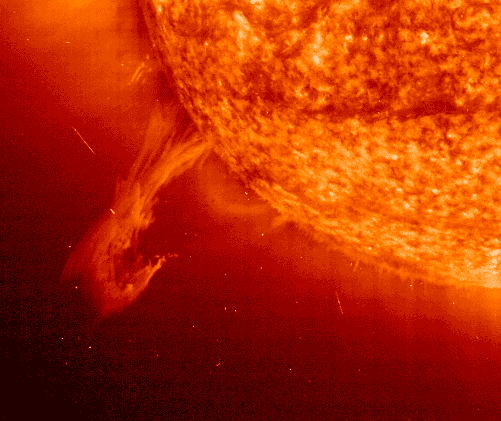 |
| This is helium light: a "rosti" picture. Note the sunspots |  |
| This is in X-rays: note the hot X-rays come from the cool sunspots! |  |
| and this looks at the mag field: Dark is a N pole, light is a S pole |  |
| And this looks at the sun at 3 different temperatures: Red at 2 million, green at 1.5 million, and blue at 1 million degrees C. |  Credit: SOHO - EIT Consortium, ESA, NASA |
| Channel name | Primary ion(s) | Region of atmosphere* | Char. log(T) |
| white light | continuum | photosphere | 3.7 |
| 1700Å | continuum | temperature minimum, photosphere | 3.7 |
| 304Åf | He II | chromosphere, transition region | 4.7 |
| 1600Åf | C IV+cont. | transition region + upper photosphere | 5.0 |
| 171Åf | Fe IX | quiet corona, upper transition region | 5.8 |
| 193Åf | Fe XII, XXIV | corona and hot flare plasma | 6.1, 7.3 |
| 211Åf | Fe XIV | active-region corona | 6.3 |
| 335Åf | Fe XVI | active-region corona | 6.4 |
| 94Åf | Fe XVIII | flaring regions (partial readout possible) | 6.8 |
| 131Åf | Fe VIII, XX, XXIII | flaring regions (partial readout possible) | 5.6, 7.0, 7.2 |

No surface in any normal sense,
|
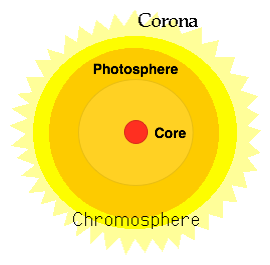 |
| Dark areas (umbra) surrounded by less dark (penumbra). Dark is relative: temperature in umbra ∼ 3800 K |
 Copyright: AURA/ NOAO |
Strong magnetic fields: typical solar mag field ∼ .01 T = 100 gauss In sunspot, can be ∼ .4 T ∼ 4000 gauss (say about 1/4 that in MRI machine) |
 |
| Can take magnetogram: look at sun in three (or more) nearby wavelengths. By subtracting these, can get "magnetic field" picture of the sun. | 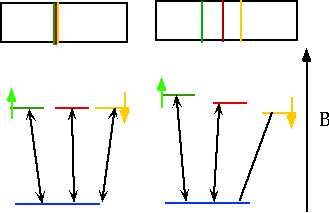 |
| Can get "magnetic field" picture of the sun. Usually in pairs (or larger groups) with opposite magnetic polarity. |
 |
Show irregular 2 × 11 year cycle:
|
 |
| Cycle is irregular, sometimes very few spots. Maunder minimum (long period of very few spots) coincided with "little ice age" in Europe (1550-1700) |
 |
| Granulation of solar surface: Hi-res pictures of sun (usually in H line) show "granules" of about 700 km radius surrounded by darker (i.e. cooler) "lanes" Lifetime ≈ few minutes. |  |
| Super-granulation: much larger structures (≈30000 km) surrounded by regions of more intense mag fields. |  |
| Spicules: "flames" of hot gas, mixed with mag fields, which appear at edge of supergranules 500 km across, extend 10,000 km above chromosphere. Speeds ≈ 20 km/s Life of 15 mins |
 |
| Prominences look very dramatic, but are actually quite benign: this shows a prominence erupting on the sun. Note that we can see these in H-light: invisible in optical since that is BB radiation and is swamped by photosphere |  |
| This shows a huge prominence erupting from the sun's surface | 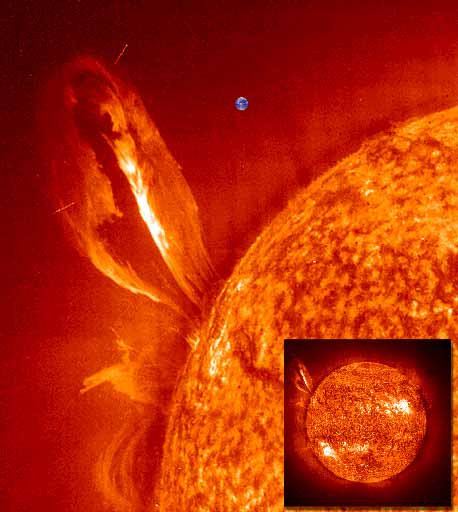
Credit: Canadain Space Agency |
| Can be studied by choosing a suitable X-ray (not masked by photosphere): e.g. OIV shows temperature of corona at 700,000 K See complex structure, which partly reflects super-granules Also can be seen in optical, by looking at forbidden lines (so low pressure) of highly ionised (so high temp) atoms. |
 |
| Hard to see corona from earth, but magnetic field concentrates matter. Coronal loop is about 50000 km high |  TRACE |
| The corona changes according to the stage of the sunspot cycle: this is at a minimum | 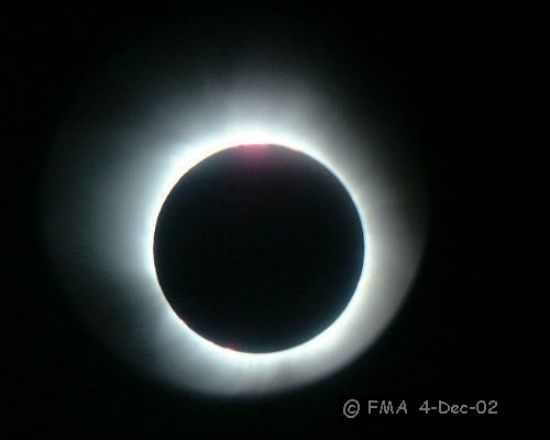 |
| and this is close to a maximum: note the huge streamers of particles blowing out |  Image Credit: High Altitude Observatory, NCAR |
| and this is a "hole" in the corona |  |
| The magnetic field interactions with the gas (plasma) trigger effects on earth.
This is a normal looking aurora (where is it?) |

|
| But we can see these from space as well | 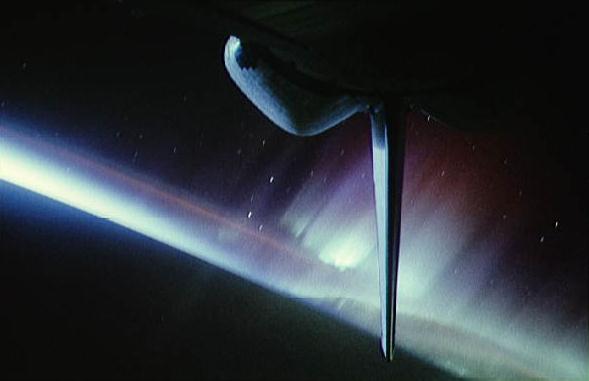 |
| And we will always get N and S auroras | 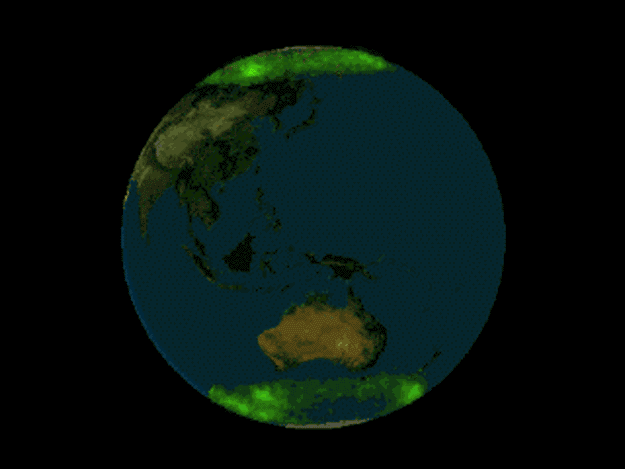 Auroras Over Both Earth Poles Credit: Polar VIS, JPL, NASA |
| This is a tube of magnetic flux on the sun: it confines particles. When it collapses, it squirts out the particles |  |
| which travel through space | 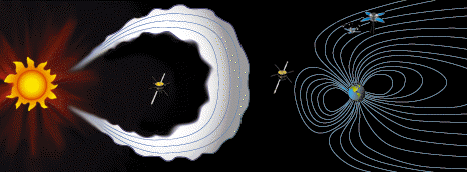 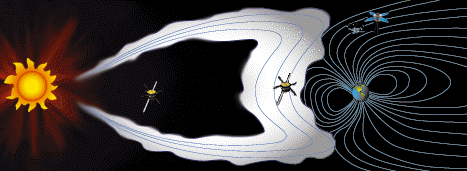 Image credit: Goddard Space Flight Center . |
| and cause a magnetic storm/aurora here on earth | 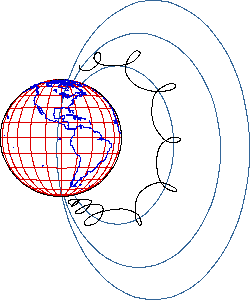 |
| The colours arise because of different interactions in the atmosphere | 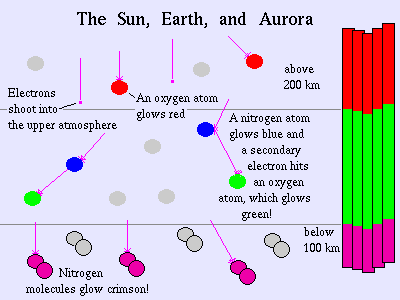
Diagram from University of Alaska Geophysical Institute |
| And while we are about it, Jupiter also has aurora: this is on the night side of the planet as seen from the Galileo space probe |  |
| and Saturn | 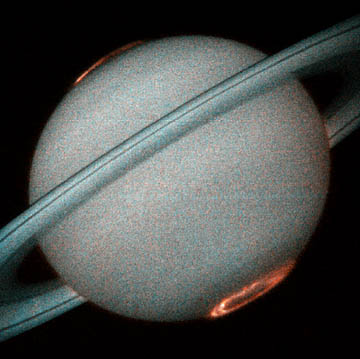
Saturn Aurora Credit: J. Trauger (JPL), NASA |